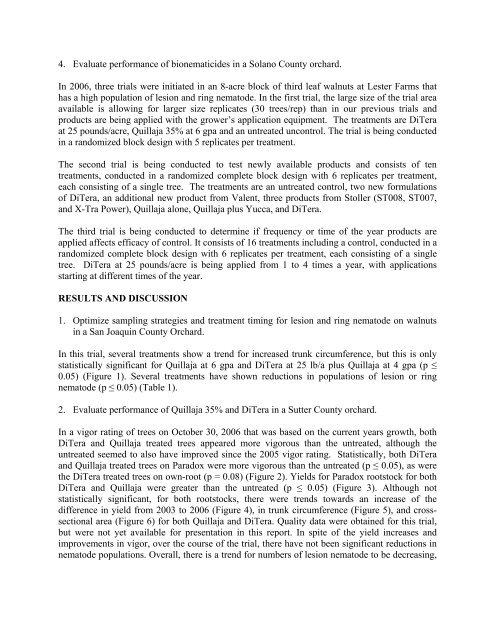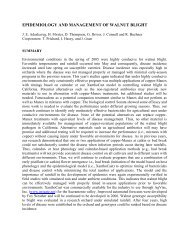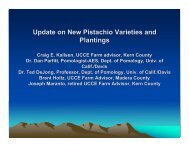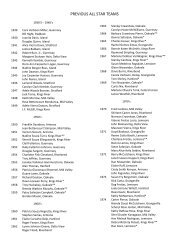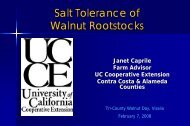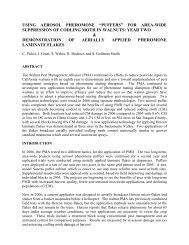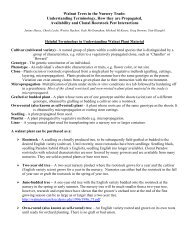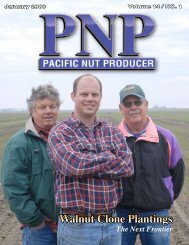nematode management in walnut orchards - Walnut Research Reports
nematode management in walnut orchards - Walnut Research Reports
nematode management in walnut orchards - Walnut Research Reports
Create successful ePaper yourself
Turn your PDF publications into a flip-book with our unique Google optimized e-Paper software.
4. Evaluate performance of bionematicides <strong>in</strong> a Solano County orchard.<br />
In 2006, three trials were <strong>in</strong>itiated <strong>in</strong> an 8-acre block of third leaf <strong>walnut</strong>s at Lester Farms that<br />
has a high population of lesion and r<strong>in</strong>g <strong>nematode</strong>. In the first trial, the large size of the trial area<br />
available is allow<strong>in</strong>g for larger size replicates (30 trees/rep) than <strong>in</strong> our previous trials and<br />
products are be<strong>in</strong>g applied with the grower’s application equipment. The treatments are DiTera<br />
at 25 pounds/acre, Quillaja 35% at 6 gpa and an untreated uncontrol. The trial is be<strong>in</strong>g conducted<br />
<strong>in</strong> a randomized block design with 5 replicates per treatment.<br />
The second trial is be<strong>in</strong>g conducted to test newly available products and consists of ten<br />
treatments, conducted <strong>in</strong> a randomized complete block design with 6 replicates per treatment,<br />
each consist<strong>in</strong>g of a s<strong>in</strong>gle tree. The treatments are an untreated control, two new formulations<br />
of DiTera, an additional new product from Valent, three products from Stoller (ST008, ST007,<br />
and X-Tra Power), Quillaja alone, Quillaja plus Yucca, and DiTera.<br />
The third trial is be<strong>in</strong>g conducted to determ<strong>in</strong>e if frequency or time of the year products are<br />
applied affects efficacy of control. It consists of 16 treatments <strong>in</strong>clud<strong>in</strong>g a control, conducted <strong>in</strong> a<br />
randomized complete block design with 6 replicates per treatment, each consist<strong>in</strong>g of a s<strong>in</strong>gle<br />
tree. DiTera at 25 pounds/acre is be<strong>in</strong>g applied from 1 to 4 times a year, with applications<br />
start<strong>in</strong>g at different times of the year.<br />
RESULTS AND DISCUSSION<br />
1. Optimize sampl<strong>in</strong>g strategies and treatment tim<strong>in</strong>g for lesion and r<strong>in</strong>g <strong>nematode</strong> on <strong>walnut</strong>s<br />
<strong>in</strong> a San Joaqu<strong>in</strong> County Orchard.<br />
In this trial, several treatments show a trend for <strong>in</strong>creased trunk circumference, but this is only<br />
statistically significant for Quillaja at 6 gpa and DiTera at 25 lb/a plus Quillaja at 4 gpa (p ≤<br />
0.05) (Figure 1). Several treatments have shown reductions <strong>in</strong> populations of lesion or r<strong>in</strong>g<br />
<strong>nematode</strong> (p ≤ 0.05) (Table 1).<br />
2. Evaluate performance of Quillaja 35% and DiTera <strong>in</strong> a Sutter County orchard.<br />
In a vigor rat<strong>in</strong>g of trees on October 30, 2006 that was based on the current years growth, both<br />
DiTera and Quillaja treated trees appeared more vigorous than the untreated, although the<br />
untreated seemed to also have improved s<strong>in</strong>ce the 2005 vigor rat<strong>in</strong>g. Statistically, both DiTera<br />
and Quillaja treated trees on Paradox were more vigorous than the untreated (p ≤ 0.05), as were<br />
the DiTera treated trees on own-root (p = 0.08) (Figure 2). Yields for Paradox rootstock for both<br />
DiTera and Quillaja were greater than the untreated (p ≤ 0.05) (Figure 3). Although not<br />
statistically significant, for both rootstocks, there were trends towards an <strong>in</strong>crease of the<br />
difference <strong>in</strong> yield from 2003 to 2006 (Figure 4), <strong>in</strong> trunk circumference (Figure 5), and crosssectional<br />
area (Figure 6) for both Quillaja and DiTera. Quality data were obta<strong>in</strong>ed for this trial,<br />
but were not yet available for presentation <strong>in</strong> this report. In spite of the yield <strong>in</strong>creases and<br />
improvements <strong>in</strong> vigor, over the course of the trial, there have not been significant reductions <strong>in</strong><br />
<strong>nematode</strong> populations. Overall, there is a trend for numbers of lesion <strong>nematode</strong> to be decreas<strong>in</strong>g,


